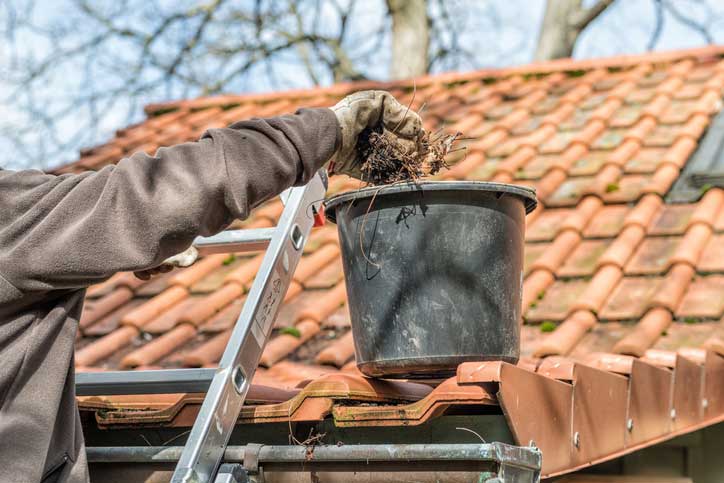5 Roof Maintenance Tips to Save You Big Bucks
Now’s a good time to give your roof some TLC — a few hours of cleaning and maintenance can extend its life by years and save you thousands of dollars. We’ll check out key things to look for and explore proper safety procedures to make the job go smoother.
Roofs face several perils including wind, water, hail, and trees. You’re at the mercy of the skies in the case of hail, but you can keep the roof “tight and right” in other ways to minimize damage. Here are 5 key checkpoints for good roof maintenance results.
- Clean the Gutters
You can purchase home improvement devices that allow you to clean gutters with either a vacuum or hose while standing on the ground. This is certainly the safer option, but it may not work for debris-packed gutters or on very tall homes. For these cases, you will have to run old school — up the rungs you go.
Use a sturdy ladder (see ladder safety below).
Wear work gloves and head-to-toe clothing.
Manually scrape the gutters out with a garden spade or scoop.
Sometimes you can wash the debris out through the downspout with a hose and sprayer, which may be easier than manually scraping. You will need to inspect and decide.
If guttering is bent, you will need to correct the problem. Check the mounting bolts for tightness and the wood for any soft spots that may have allowed guttering to work loose.
- Get the Water Away
Leaking gutters can cause foundation problems and wood rot. It’s a simple fix; test-fill your gutters from either the ground or on a ladder with a hose to spot any leaks along the drainage path. Most of these can be repaired with sealant. Make sure the water flows away from the house once the gutter has done its job. Consult a professional if you’re unsure.
- Inspect the Shingles
Loose shingles may allow water to seep into your house, and they are also vulnerable to blowing off during strong winds. Shingles can be inspected with a pair of binoculars from the ground, but this method may not work in all cases. If you find problems, do not attempt climbing on a steep roof; call a pro. If your home has a gentler roof slope, you might try it yourself. Take a hammer and some extra roofing fasteners and tap down any loose nails or shingles.
- Seal Up Roof Cracks
Another thing to inspect for on your roof are cracks. They might appear around any surface that pokes through the roof, like a vent, chimney, or satellite dish. Close up any that you find with roof sealant or caulk. For large cracks, you will want to apply a second coat after the first one dries. Read label directions for best practices with the product.
- Back Off the Branches
A tree branch that is several feet away from the roof on a calm day may be busily scraping back and forth on your shingles when it’s windy. Examine the tree branches near your home and trim away any that might swing across the roof during storms. A pruning saw might keep you from having to use a ladder. Trimming trees away from the roof will also reduce leaf accumulation in your gutters.

Ladder Safety
About 164,000 Americans are treated each year for injuries from ladder accidents. Don’t be one of them! Follow a few simple tips to stay safe if you’re working on a ladder:
- Wear snugly fitting shoes with a good grip; avoid sandals, tennis shoes, and the like that are likely to slip. Make sure the rungs are free of dirt, oil, and other debris.
- Place the ladder on a level surface where all of the legs are on solid footing. Avoid placing it over mud or other unsteady surfaces where it might shift under your weight.
- Use the proper angle — the base of a leaning ladder should be 1 foot away from the wall for every 4 feet of height, so a 12-foot ladder’s base should be 3 feet away from the home.
- Do not work from the top step. Most ladders will have a label specifying the highest safe step to use. This is one of the most important safety tips. Don't ignore it!
- It is preferable to have someone hold the ladder when you are working on it. If this is not possible, go slow and avoid sudden movements.
Annual Roof Maintenance
A roof should last 15 to 25 years depending on the climate, but the lifespan of your roof also depends on how well you take care of it. Just a few hours of maintenance effort per year will pay big dividends, while neglect can cut its life in half.
Steve LaNore is a certified broadcast meteorologist with more than 30 years forecasting and technical experience. He has provided meteorological consulting for everything from insurance adjusters to court cases and is a nine-time award-winning author and broadcaster. LaNore has authored two books, available on Amazon. He resides in north Texas near beautiful Lake Texoma.





